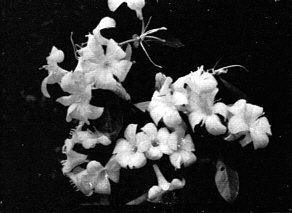QBARS - v12n4 A New Guinea Rhododendron
A New Guinea Rhododendron
By Frank Doleshy, Seattle, Washington
There is a new slide in the Society's collection, showing quite a handsome rhododendron. The flower has a long, yellow tube, topped with a flat face of apricot and pink. But the name of this plant is not known. Here is the story. For a long time, I've wondered about the New Guinea Rhododendrons, and hoped for some introductions. Last fall, there was some talk of a New Guinea expedition. But this seemed to fall into dormancy. So I wrote directly to the New Guinea forestry department.
They replied in a very friendly manner. They didn't know of any collectors who planned to go to the higher mountains, but said they would try to put me in touch with any such expedition. Meanwhile, they were about to do some collecting for Kew and Leiden at lower altitudes, and said they would send me any surplus seed.
This arrived soon, and they loaned me a slide of the plant. The Society now has a copy of it.
In describing this rhododendron, they said: "This is the large flower variety found growing on sunny mountain slopes between 3500 feet and 4500 feet amongst small trees and scrambling shrubs, generally on the edge of grassy clearings. There are two colour varieties here, bright butter-cup yellow, and orange-apricot...Collected near Zenag, Morobe District, T.N.G. 3500-4200 feet."
They didn't give a name, and I'm not sure that anybody could. This particular species may or may not be described as yet. And, even if it is described, the type material may have been lost in the bombing of Hamburg. So, for the present, we'll have to use a temporary designation. I suggest "Morobe No. 1." (Fig. 37)

|
|
Fig. 37. R. Morobe No. 1
A rhododendron from New Guinea. |
The seed of this plant is astonishing. Without a lens, it looks like little threads. It is long-tailed, somewhat like that of R. vaccinioides , but even more light and fluffy. I wasn't sure I could grow such an exotic plant, and rushed some to friends in the nursery business, and to the University of Washington Arboretum. In turn, the Arboretum sent some to the University of California Botanical Garden. But I needn't have worried. Germination was 95%.
Now for the question of whether we have something worth while. Kingdon Ward once stated that he had seen nothing but lepidotes from New Guinea.* And the seeds of this plant look like those of certain lepidotes. Examining the little seedlings under my microscope, I can see projections which may develop into scales, but it is too early to be certain. So I can only say that we may have a large flowered yellow-and-apricot lepidote. Being practically equatorial, it should have a long blooming season.
At least for the greenhouse, it seems interesting. And I think the hybridizers may see some possibilities.
I hope that this is only the first of many New Guinea introductions. Some may even be hardy here; don't forget that the New Guinea mountains rise to 16,500 feet, and have snow fields.
With further introductions, we should learn a great deal. Some of these rhododendrons may be linked with R. vaccinioides , stamineum and ovatum . But, from the high country, I think we might get some living fossils, left behind after the last ice age. These may turn out to be the ancestors of R. anthopogon , saluenense, and other series. Also, we might receive a missing link, which lies between (a) R. falconeri-grande , and (b) the Asiatic lepidotes. Such a plant has been anticipated by some, and considered impossible by others.
The botanists are going to have their problems with these rhododendrons. To avoid confusion, let's remember that any temporary names will eventually be dropped. And let's avoid the curious practice of lumping all New Guinea Rhododendrons together and calling them "Javanicums." This name hardly seems right for a new population of plants, which may include alpines as well as tropicals.
* R. H. S. Rhododendron Year Book, Number Two (1947), p. 101.
